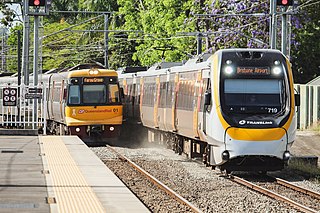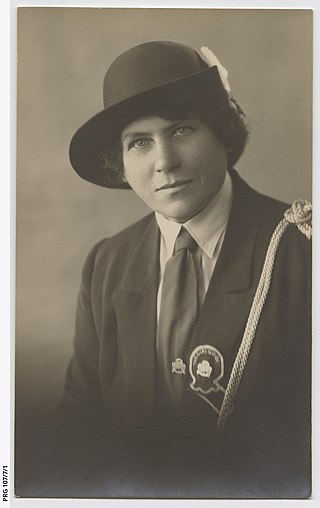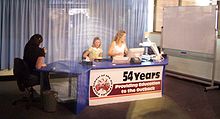
Rail transport in Australia is a component of the Australian transport system. It is to a large extent state-based, as each state largely has its own operations, with the interstate network being developed ever since Australia's federation in 1901. As of 2022, the Australian rail network consists of a total of 32,929 kilometres (20,461 mi) of track built to three major track gauges: 18,007 kilometres (11,189 mi) of standard gauge, 2,685 kilometres (1,668 mi) of broad gauge, and 11,914 kilometres (7,403 mi) of narrow gauge lines. Additionally, about 1,400 kilometres (870 mi) of 610 mm / 2 ft gauge lines support the sugar-cane industry. 3,488 kilometres (2,167 mi), around 11 percent of the Australian heavy railways network route-kilometres are electrified.

Stuart Highway is a major Australian highway. It runs from Darwin, in the Northern Territory, via Tennant Creek and Alice Springs, to Port Augusta in South Australia; it has a distance of 2,720 km (1,690 mi). Its northern and southern extremities are segments of Australia's Highway 1. The principal north–south route through the central interior of mainland Australia, the highway is often referred to simply as "The Track".

The Royal Flying Doctor Service (RFDS), commonly known as the Flying Doctor, is an air medical service in Australia. It is a non-profit organisation that provides emergency and primary health care services for those living in rural, remote and regional areas of Australia who cannot access a hospital or general practice due to the vast distances of the Outback.
Alfred Hermann Traeger, known as Alf Traeger, was an Australian engineer and inventor, chiefly known for the development of the pedal radio used by both the School of the Air and by the Royal Flying Doctor Service.

Meekatharra is a town in the Mid West region of Western Australia. Meekatharra is a Yamatji word meaning "place of little water". At the 2016 census, Meekatharra had a population of 708, with 34.0% being of Aboriginal descent.
Australians generally assumed in the 1850s that railways would be built by the private sector. Private companies built railways in the then colonies of Victoria, opened in 1854, and New South Wales, where the company was taken over by the government before completion in 1855, due to bankruptcy. South Australia's railways were government owned from the beginning, including a horse-drawn line opened in 1854 and a steam-powered line opened in 1856. In Victoria, the private railways were soon found not to be financially viable, and existing rail networks and their expansion were taken over by the colony. Government ownership also enabled railways to be built to promote development, even if not apparently viable in strictly financial terms. The railway systems spread from the colonial capitals, except for a few lines that hauled commodities to a rural port.

MacRobertson Miller Airlines (MMA) was a Western Australian airline that operated between 1927 and 1993. It served a changing roster of destinations in Western Australia and the Northern Territory, concentrated on services between Perth and Darwin via towns in the Pilbara and Kimberley regions. After being purchased by Ansett Transport Industries in 1968, MMA grew to become Australia's third-largest airline. It gradually lost its independent identity under Ansett ownership, being eventually rebranded Ansett WA before being entirely subsumed into Ansett Australia in the early 1990s.

The Australian Rail Track Corporation (ARTC) is an Australian Government-owned statutory corporation. It operates one of the largest rail networks in the nation, spanning 8,500 km across five states and 39 worksites.
QantasLink is a full-service, regional brand of Australian flag carrier Qantas and is an affiliate member of the Oneworld airline alliance. As of 2024, QantasLink provides over 2,000 flights each week to 65 metropolitan, regional and remote destinations across Australia, as well as short-haul international services to Singapore, the Solomon Islands, New Caledonia and East Timor. Flights are operated by the Qantas owned subsidiaries of Eastern Australia Airlines, National Jet Systems, Network Aviation and Sunstate Airlines, with E190s wet-leased from Alliance Airlines.
The Clontarf Foundation is a not-for-profit organisation that assists in the education and employment of young Aboriginal and Torres Strait Islander men.

The electoral district of Pilbara is a Legislative Assembly electorate in the state of Western Australia. Pilbara is named for the region of Western Australia in which it is located. It is one of the oldest electorates in Western Australia, with its first member having been elected to the Second Parliament of the Legislative Assembly at the 1894 elections.
The VKS-737 Radio Network is a division of the Australian National 4WD Radio Network, a national Public Benevolent Institution, established for Outback travellers who are in distress by providing them with emergency assistance and support in cooperation with other organisations.

The Division of Durack is an Australian Electoral Division in the state of Western Australia.
CDT is an Australian digital television station broadcasting in remote central and eastern Australia. It is jointly owned by Southern Cross Austereo and Imparja Television Pty Ltd and operates under the company name Central Digital Television.

Adelaide Laetitia "Addie" Miethke,, was a South Australian educator and teacher who was pivotal in the formation of the School of the Air using the existing Royal Flying Doctor Service radio network.
The Round Australia Trial was a long distance rally, which was run on multiple occasions between 1953 and 1998, circumnavigating Australia. Its early years were tremendously popular as the roads through large portions of the country, particularly west of Adelaide, were unformed. Automobile manufacturers enthused over the event as it provided a particularly severe test event for their products, proving their cars were able to stand up to whatever conditions remote Australia could provide. Early editions of the event were heroic tests and were front-page fodder for the newspapers of the era.

The Alice Springs School of the Air is a distance education organization based in Alice Springs which provides teaching, education materials and personal communication for remote children in the Northern Territory outback of Australia.










